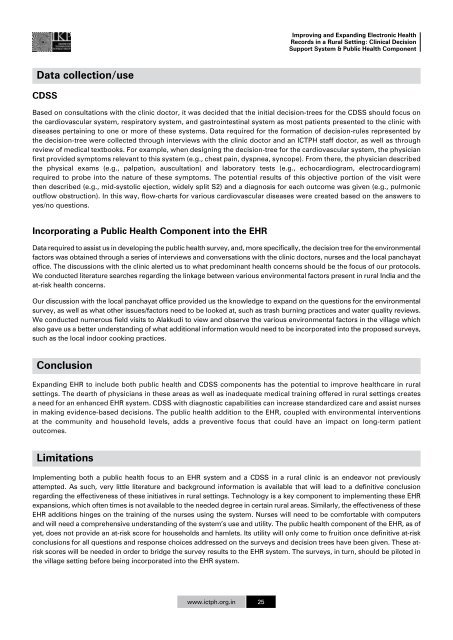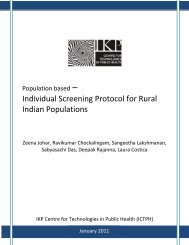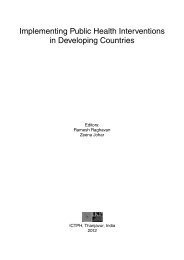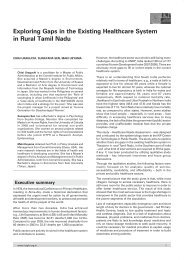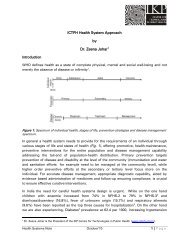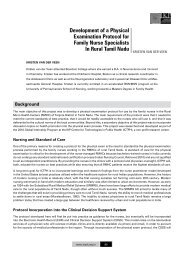Improving and Expanding Electronic Health Records in a Rural Setting
Improving and Expanding Electronic Health Records in a Rural Setting
Improving and Expanding Electronic Health Records in a Rural Setting
Create successful ePaper yourself
Turn your PDF publications into a flip-book with our unique Google optimized e-Paper software.
<strong>Improv<strong>in</strong>g</strong> <strong>and</strong> Exp<strong>and</strong><strong>in</strong>g <strong>Electronic</strong> <strong>Health</strong><br />
<strong>Records</strong> <strong>in</strong> a <strong>Rural</strong> Sett<strong>in</strong>g: Cl<strong>in</strong>ical Decision<br />
Support System & Public <strong>Health</strong> Component<br />
Data collection/use<br />
CDSS<br />
Based on consultations with the cl<strong>in</strong>ic doctor, it was decided that the <strong>in</strong>itial decision-trees for the CDSS should focus on<br />
the cardiovascular system, respiratory system, <strong>and</strong> gastro<strong>in</strong>test<strong>in</strong>al system as most patients presented to the cl<strong>in</strong>ic with<br />
diseases perta<strong>in</strong><strong>in</strong>g to one or more of these systems. Data required for the formation of decision-rules represented by<br />
the decision-tree were collected through <strong>in</strong>terviews with the cl<strong>in</strong>ic doctor <strong>and</strong> an ICTPH staff doctor, as well as through<br />
review of medical textbooks. For example, when design<strong>in</strong>g the decision-tree for the cardiovascular system, the physician<br />
first provided symptoms relevant to this system (e.g., chest pa<strong>in</strong>, dyspnea, syncope). From there, the physician described<br />
the physical exams (e.g., palpation, auscultation) <strong>and</strong> laboratory tests (e.g., echocardiogram, electrocardiogram)<br />
required to probe <strong>in</strong>to the nature of these symptoms. The potential results of this objective portion of the visit were<br />
then described (e.g., mid-systolic ejection, widely split S2) <strong>and</strong> a diagnosis for each outcome was given (e.g., pulmonic<br />
outflow obstruction). In this way, flow-charts for various cardiovascular diseases were created based on the answers to<br />
yes/no questions.<br />
Incorporat<strong>in</strong>g a Public <strong>Health</strong> Component <strong>in</strong>to the EHR<br />
Data required to assist us <strong>in</strong> develop<strong>in</strong>g the public health survey, <strong>and</strong>, more specifically, the decision tree for the environmental<br />
factors was obta<strong>in</strong>ed through a series of <strong>in</strong>terviews <strong>and</strong> conversations with the cl<strong>in</strong>ic doctors, nurses <strong>and</strong> the local panchayat<br />
office. The discussions with the cl<strong>in</strong>ic alerted us to what predom<strong>in</strong>ant health concerns should be the focus of our protocols.<br />
We conducted literature searches regard<strong>in</strong>g the l<strong>in</strong>kage between various environmental factors present <strong>in</strong> rural India <strong>and</strong> the<br />
at-risk health concerns.<br />
Our discussion with the local panchayat office provided us the knowledge to exp<strong>and</strong> on the questions for the environmental<br />
survey, as well as what other issues/factors need to be looked at, such as trash burn<strong>in</strong>g practices <strong>and</strong> water quality reviews.<br />
We conducted numerous field visits to Alakkudi to view <strong>and</strong> observe the various environmental factors <strong>in</strong> the village which<br />
also gave us a better underst<strong>and</strong><strong>in</strong>g of what additional <strong>in</strong>formation would need to be <strong>in</strong>corporated <strong>in</strong>to the proposed surveys,<br />
such as the local <strong>in</strong>door cook<strong>in</strong>g practices.<br />
Conclusion<br />
Exp<strong>and</strong><strong>in</strong>g EHR to <strong>in</strong>clude both public health <strong>and</strong> CDSS components has the potential to improve healthcare <strong>in</strong> rural<br />
sett<strong>in</strong>gs. The dearth of physicians <strong>in</strong> these areas as well as <strong>in</strong>adequate medical tra<strong>in</strong><strong>in</strong>g offered <strong>in</strong> rural sett<strong>in</strong>gs creates<br />
a need for an enhanced EHR system. CDSS with diagnostic capabilities can <strong>in</strong>crease st<strong>and</strong>ardized care <strong>and</strong> assist nurses<br />
<strong>in</strong> mak<strong>in</strong>g evidence-based decisions. The public health addition to the EHR, coupled with environmental <strong>in</strong>terventions<br />
at the community <strong>and</strong> household levels, adds a preventive focus that could have an impact on long-term patient<br />
outcomes.<br />
Limitations<br />
Implement<strong>in</strong>g both a public health focus to an EHR system <strong>and</strong> a CDSS <strong>in</strong> a rural cl<strong>in</strong>ic is an endeavor not previously<br />
attempted. As such, very little literature <strong>and</strong> background <strong>in</strong>formation is available that will lead to a def<strong>in</strong>itive conclusion<br />
regard<strong>in</strong>g the effectiveness of these <strong>in</strong>itiatives <strong>in</strong> rural sett<strong>in</strong>gs. Technology is a key component to implement<strong>in</strong>g these EHR<br />
expansions, which often times is not available to the needed degree <strong>in</strong> certa<strong>in</strong> rural areas. Similarly, the effectiveness of these<br />
EHR additions h<strong>in</strong>ges on the tra<strong>in</strong><strong>in</strong>g of the nurses us<strong>in</strong>g the system. Nurses will need to be comfortable with computers<br />
<strong>and</strong> will need a comprehensive underst<strong>and</strong><strong>in</strong>g of the system’s use <strong>and</strong> utility. The public health component of the EHR, as of<br />
yet, does not provide an at-risk score for households <strong>and</strong> hamlets. Its utility will only come to fruition once def<strong>in</strong>itive at-risk<br />
conclusions for all questions <strong>and</strong> response choices addressed on the surveys <strong>and</strong> decision trees have been given. These atrisk<br />
scores will be needed <strong>in</strong> order to bridge the survey results to the EHR system. The surveys, <strong>in</strong> turn, should be piloted <strong>in</strong><br />
the village sett<strong>in</strong>g before be<strong>in</strong>g <strong>in</strong>corporated <strong>in</strong>to the EHR system.<br />
www.ictph.org.<strong>in</strong> 25


